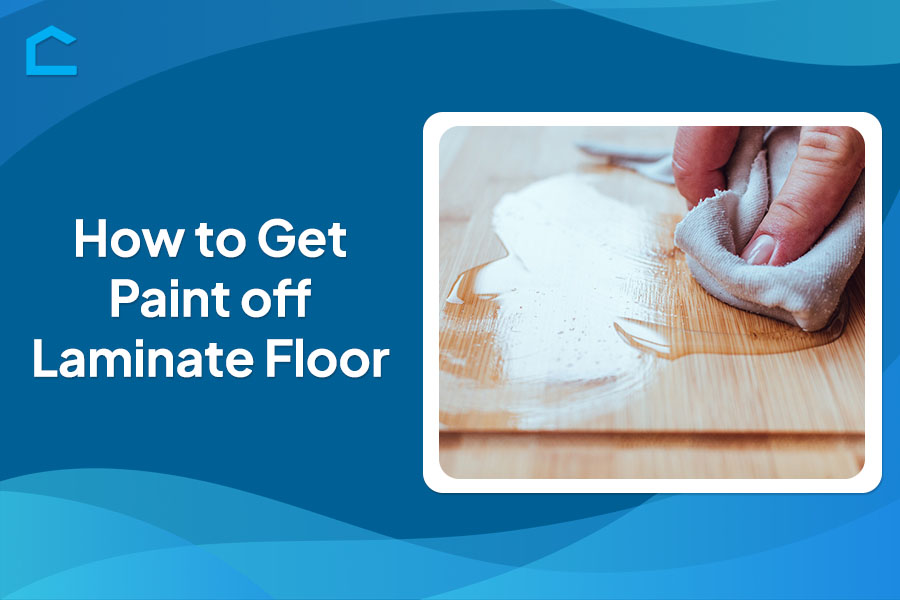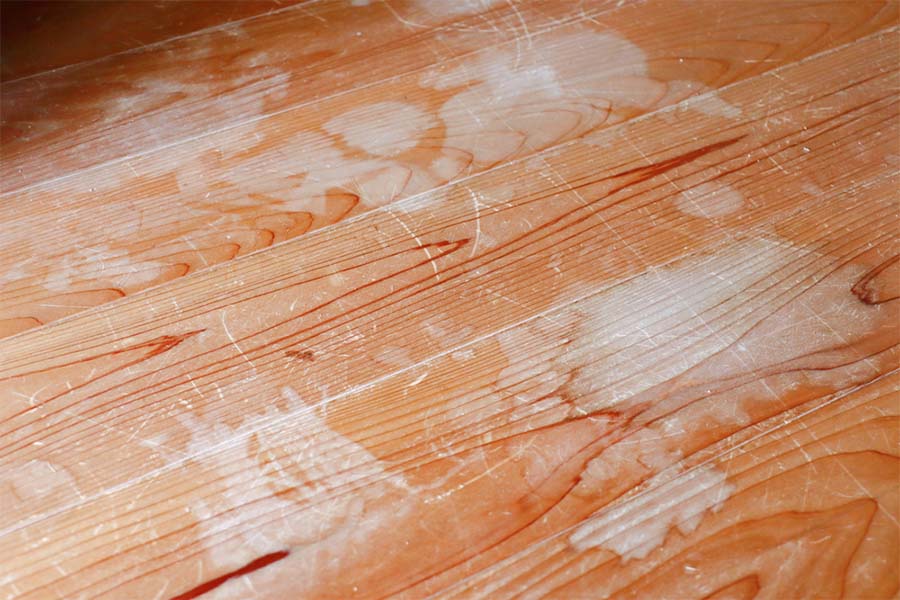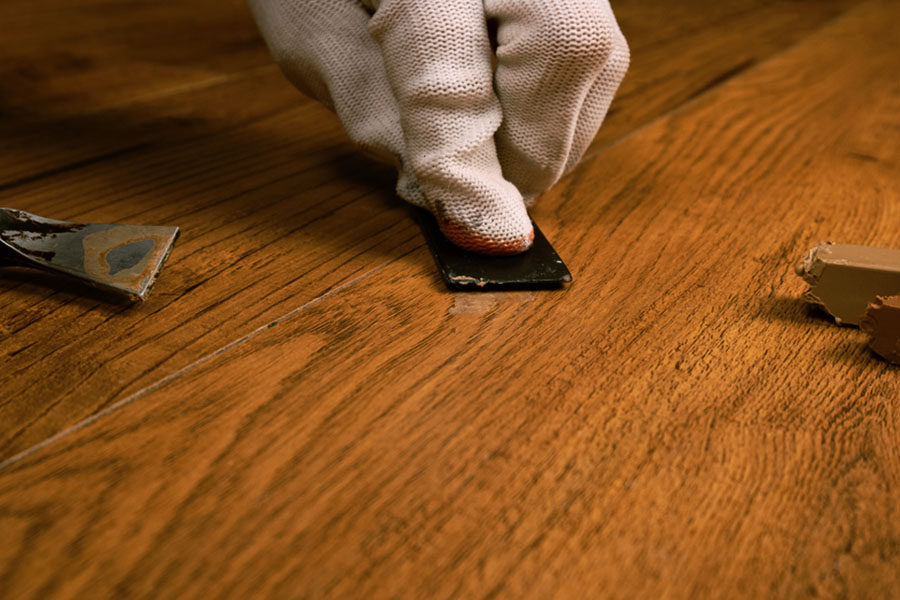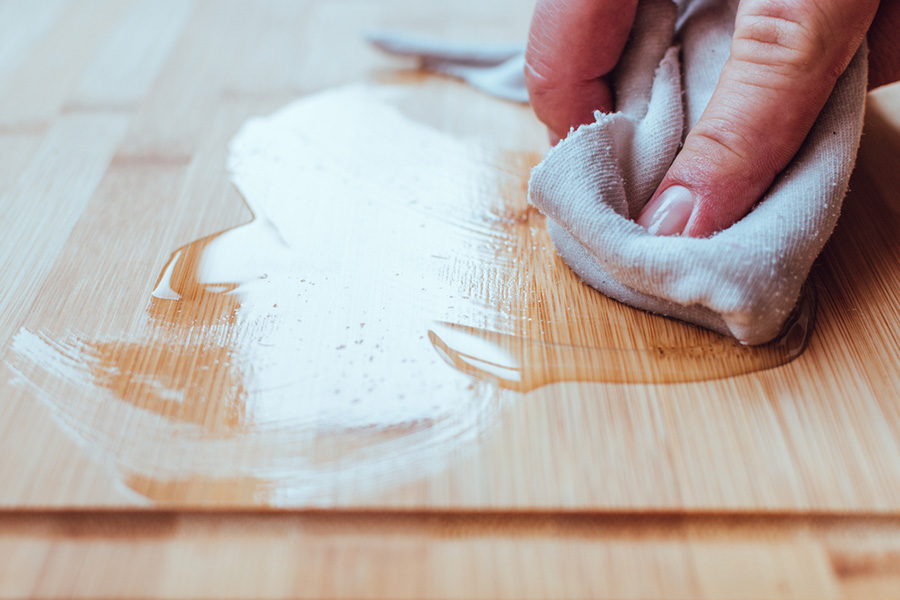How to Get Paint off Laminate Floor

Many homeowners choose laminate floors due to their durability and ease of maintenance. However, accidents can happen, and spilled paint can be a nightmare to clean up, especially on these smooth surfaces. So, you need to learn how to get paint off laminate floor with ease.
In this article, we’ll explore various methods, from simple household solutions to professional-grade products. You will discover the right tools and products to use, as well as tips and tricks to make the process easier and more efficient.
Get ready to learn effective ways to eliminate those unsightly paint stains once and for all.

Source: shutterstock.com / Photo Contributor: umaruchan4678
How to Get Paint off Laminate Floor
To remove paint from a laminate floor, begin by softly scraping the dried paint using a plastic scraper or putty knife, taking care not to scratch the floor. If the paint remains, try rubbing it with a damp cloth in warm, soapy water.
For more persistent stains, you can apply a bit of rubbing alcohol or nail polish remover on a cloth but test it first in an inconspicuous spot to prevent laminate damage.
After removing the paint, clean the area with a damp cloth and ensure it is thoroughly dried. Additionally, place protective coverings or mats in high-risk areas to prevent future paint spills. With proper care, your floors can maintain their pristine appearance.
General techniques for paint removal
Removing paint from laminate floors typically involves using solvents such as paint thinners or solvent-based cleaners. These substances effectively soften and lift both fresh and dried paint spills.
For fresh spills, blot up excess paint and apply the solvent. Let it sit briefly, then gently scrub it with a soft brush.
For dried paint stains, apply heat with a hot air gun or iron held a few inches away. This softens the paint, making it easier to carefully scrape off with a plastic putty knife. Before applying any method, we advise you to sweep away debris for better results.
Additionally, safety is crucial when removing paint from laminate floors. You should work in a well-ventilated area, wear gloves and eye protection, and avoid inhaling fumes or direct contact with hot surfaces.
How to Get Water-Based Paint off Laminate Floor
Understanding water-based paints, such as latex or acrylic paints, are popular choices for indoor painting projects. This is because they are low odor and easy to clean with water. However, if not addressed promptly, these paints can still be challenging to remove from laminate flooring.
Water-based paints can seep into the seams and grooves of laminate floors, making them more difficult to remove compared to smooth, non-porous surfaces. If left to dry completely, the paint can become firmly embedded, potentially damaging the laminate’s protective coating.
Tackling fresh spills
Quick action is crucial when dealing with fresh water-based paint spills on laminate floors. Start by blotting up as much excess paint as you can using paper towels or clean, absorbent rags. Be sure to blot gently to avoid spreading the paint.
After removing the excess paint, dampen a clean cloth or sponge with warm water and a few drops of mild dish soap or a pH-neutral cleaner. Gently scrub the affected area in a circular motion, applying moderate pressure to lift the paint from the laminate surface.
Removing dried paint
If water-based paint has already dried on the laminate floor, a more aggressive approach might be needed. Begin by gently scoring the dried paint with a plastic putty knife or scraper to break the surface tension and create small cracks for the cleaning solution to penetrate.
Next, mix a solution of warm water with white vinegar or ammonia (never use them together). Dip a scrub brush or non-abrasive scouring pad into the solution and scrub the painted area firmly, focusing on the cracks and grooves where the paint has dried.

Source: shutterstock.com / Photo Contributor: fukume
Finishing touches
After successfully removing the water-based paint, rinse the area thoroughly with clean water to eliminate any remaining cleaning solution or paint residue. Then, dry the floor completely using clean, absorbent towels or a mop.
If there are stubborn stains or discoloration, consider applying a laminate floor cleaner or polish. These products are designed to restore the surface shine and protect the flooring from future damage.
By following these tips, you can effectively remove water-based paint stains from your laminate floors. This minimizes the risk of permanent damage or discoloration.
How to Remove Dried Gloss Paint From Laminate Flooring
Removing dried gloss or high-sheen paint from laminate floors can be very difficult. The smooth, non-porous surface of laminate flooring allows the glossy paint to form a strong bond, making it resistant to many common cleaning methods.
Scrubbing or scraping off dried gloss paint often leads to unsightly scratches or damage to the laminate’s protective layer. The older and more stubborn the paint stain, the higher the risk of permanently damaging the floor’s surface.
Specialized solvents and strippers
When you encounter dried gloss paint on laminate flooring, using specialized solvents or paint strippers can help dissolve the paint’s bond with the surface. It’s important to choose products designed for removing oil-based or alkyd paints, as these are usually more effective than water-based cleaners.
However, before applying any solvent or stripper, it’s essential to test it on a hidden part of the laminate to check for any potential discoloration or damage. Follow the instructions provided with the product closely, and work in a well-ventilated area while wearing suitable personal protective equipment.
Heat application
In addition to solvents, the application of heat can be a useful technique for softening and lifting dried gloss paint from laminate floors. You can use a handheld hot air gun or a household iron set to its highest temperature, keeping it a few inches away from the floor to prevent overheating and damage.
We recommend you move the heat source back and forth over the painted area until the paint starts to soften and bubble. Afterward, delicately scrape off the softened paint using a plastic putty knife or a laminate floor scraper designed for the task, being careful not to scratch the surface.
Abrasive pads and scrubbing
To tackle stubborn areas where gloss paint has adhered to your laminate floor, use a non-abrasive scrubbing pad or a specialized laminate floor cleaning pad. Soak the pad in a solvent-based cleaning solution and scrub firmly on the painted spots, especially in the grooves and seams where the paint collects.
Also, avoid using abrasive scouring pads or steel wool, which can scratch and damage the laminate surface. We advise you to always scrub gently and follow the direction of the laminate’s grain to minimize the risk of permanent scratches or blemishes.
By following these specialized methods and using the right products, you can effectively remove even the toughest dried gloss paint stains from your laminate flooring. These techniques are specifically designed to preserve the floor’s appearance and integrity.
How to Remove Oil Based Paint From Laminate Flooring
Removing oil-based paints such as enamels and alkyds from laminate flooring can be tricky because these paints stick tightly to the surface. Regular cleaning methods might not work well or cause scratches or damage.
To deal with oil-based paint stains, you’ll need special solvents and paint strippers made specifically for these paints. These products effectively break down the bond. You can also apply heat with a hot air gun or iron to soften and lift dried paint, making it easier to scrape off gently.
For tough spots, using non-abrasive scrubbing pads with solvent-based solutions can help. Pay attention to the grooves where paint accumulates, but avoid anything abrasive that could scratch the surface. Plus, taking proper precautions when using solvents and heat on laminate floors is important to avoid accidents.
You can effectively remove stubborn oil-based paint stains while keeping your laminate flooring safe. But remember to test products first, ensure good ventilation, and use protective equipment to stay safe.

Source: shutterstock.com / Photo Contributor: Sergio Arjona
Precautions and Tips
When it comes to removing paint from laminate floors, safety and protecting the surface should be your main concerns. As mentioned, start by working in a well-ventilated area and wearing protective gear like gloves, goggles, and a respirator mask if you’re using solvents or heat.
Before diving into the cleaning process, it’s essential to test any cleaning products or methods in a hidden spot first. This step ensures they won’t harm or change the color of your laminate.
Additionally, be cautious not to saturate the floor with too much moisture, as this can cause swelling by seeping into the seams. Stick to plastic putty knives or specialized laminate scrapers, gently scraping along the grain to avoid scratches.
Once you’ve successfully removed the paint stains, make sure to thoroughly rinse and dry the area. Consider applying a laminate floor polish or sealer to restore the protective coating. By taking these precautions and testing beforehand, you can effectively remove paint.
Conclusion
Learning how to get paint off laminate floor is essential for maintaining their pristine appearance and durability. So, we covered various methods tailored to different types of paint stains.
From tackling water-based paint spills to dealing with stubborn dried gloss or oil-based paint, we outlined step-by-step instructions and precautions to ensure safe and effective removal. Additionally, we emphasized the importance of testing cleaning products, working in well-ventilated areas, and using appropriate protective gear.
By following the advice outlined here, you can confidently address paint spills on their laminate floors while minimizing the risk of damage or discoloration. With the right tools, products, and techniques, you’ll be equipped to restore your laminate floors to their original condition, free from unsightly paint stains.
